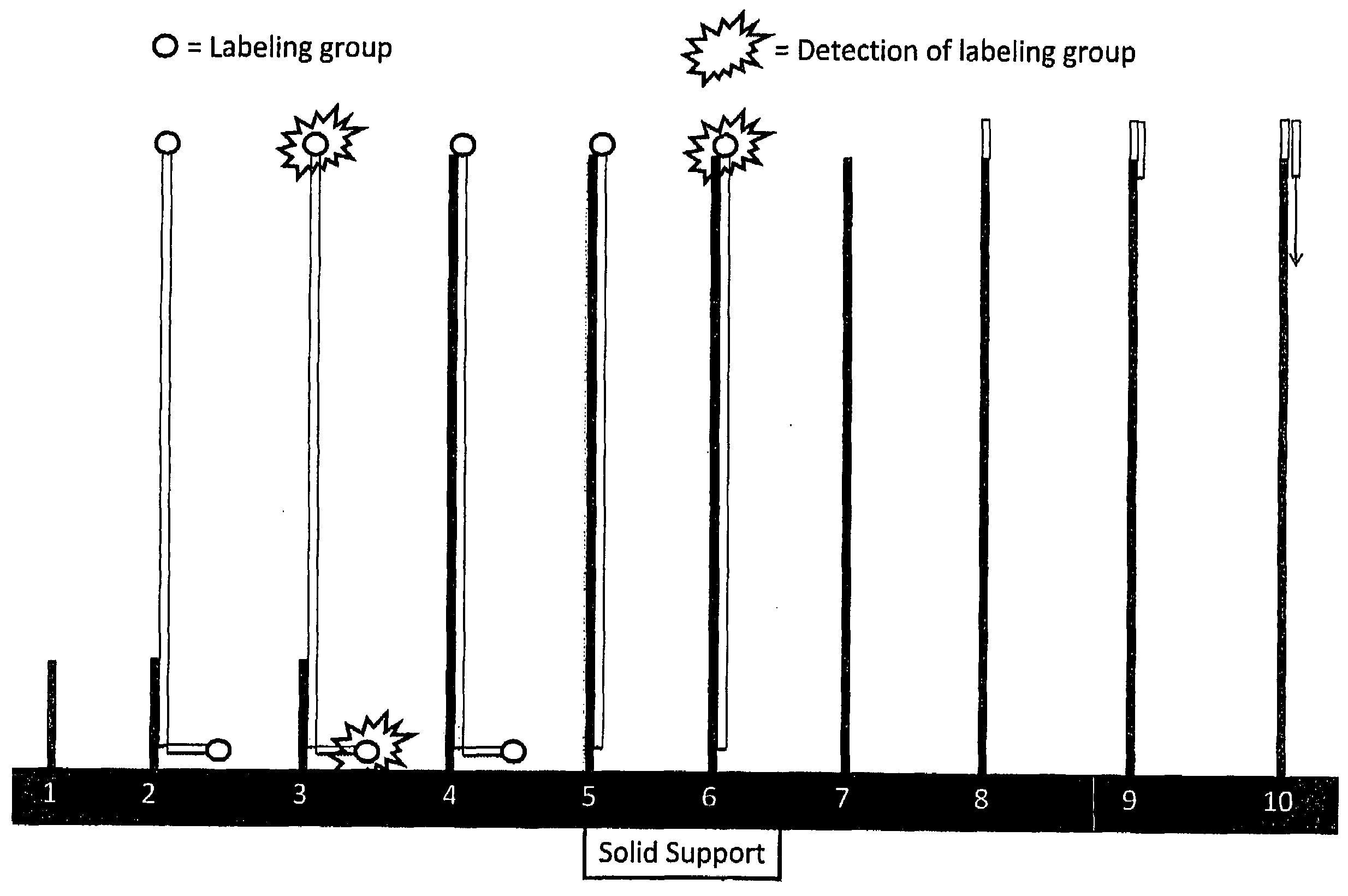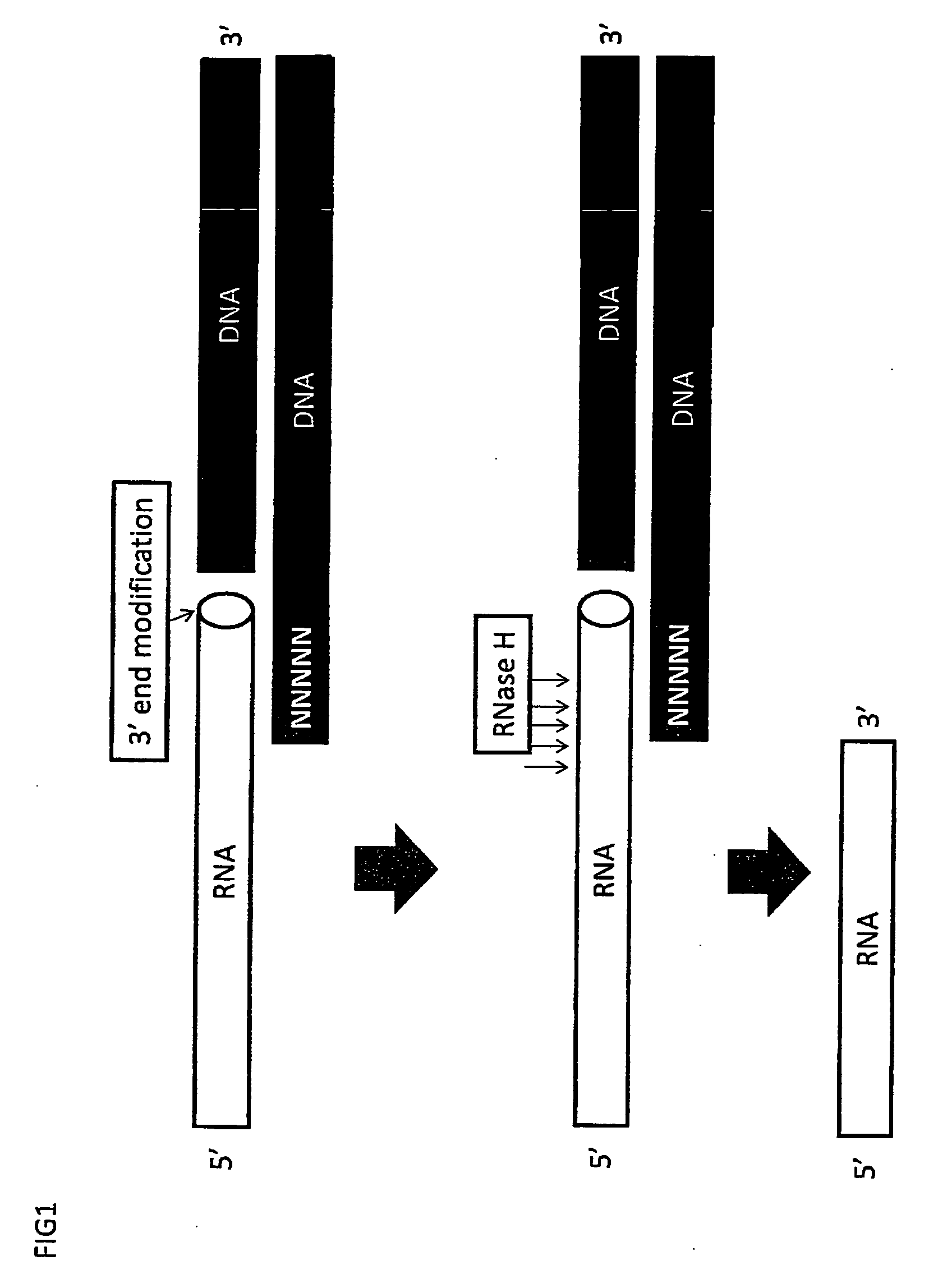RNA sequencing and analysis using solid support
- Summary
- Abstract
- Description
- Claims
- Application Information
AI Technical Summary
Benefits of technology
Problems solved by technology
Method used
Image
Examples
example 1
Isolation of RNA
[0268]First, total RNA samples are prepared using commercial reagents and standard methods known to a person skilled in the art of molecular biology, as given in more detail, for example, in Sambrook J. and Russuell D. W., Molecular Cloning, A Laboratory Manual, Cold Spring Harbor Laboratory Press, New York, 2001. Furthermore, Carninci P. et al. described in Biotechniques 33, 306-309 (2002) a method to obtain cytoplasmic RNA fractions. It is within the scope of the invention to prepare total RNA after cell fractionation, namely from the nucleus and cytoplasm of cells.
[0269]The quality of RNA samples can be analyzed by the ratios of the OD readings at 230, 260 and 280 nm to monitor RNA purity. Removal of polysaccharides is considered successful when the 230 / 260 ratio is lower than 0.5, and an effective removal of proteins is achieved when the 260 / 280 ratio is higher than 1.8 or around 2.0. The RNA samples can further be analyzed by electrophoresis in an agarose gel or...
example 2
Pyrophosphatase Reaction to Remove Cap Structure
[0270]The total RNA sample is treated with a pyrophosphatase to remove the Cap structure from the 5′ end of mRNA. In a typical reaction 3 μg of total RNA are incubated at 65° C. for 5 min in a total volume of 42.9 μl water to destroy secondary structures. The RNA is afterwards chilled on ice until setting up the reaction by adding:
RNA (3 μg)42.9 μl 10x TAP buffer5 μlCloned RNase Inhibitor (40 U / μl (Takara)2 μlTobacco acid pyrophosphatase (150 U / μl)0.1 μl Total volume50 μl
[0271]After incubation at 37° C. for 1 h, the reaction mixture is extracted with 50 μl phenol / chloroform, followed by 50 μl chloroform only. For further purification the RNA is precipitated with isopropanol using glycogen as a carrier:
1 μg / μl Glycogen3 μl5M NaCl5 μlIsopropanol100 μl
[0272]After incubation at −20° C. for at least 30 min or overnight, the precipitate is collected by centrifugation at 15,000 rpm and 4° C. for 30 min. The pellet is washed first with 800...
example 3
Ligation of an Oligonucleotide to the 3′ End of RNA
[0273]Ligation of an RNA oligonucleotide to the 3′ end of RNA can be performed by means of an RNA ligase. Features of the RNA oligonucleotide are further described in the description of the invention.
[0274]To conduct the ligation reaction, 1 μg of total RNA is mixed with 100 pmol of RNA oligonucleotide, and water is added up to a final volume of 15.34 μl. The mixture is incubated at 65° C. for 5 min and placed on ice. For the ligation reaction the following reagents are added:
RNA sample and oligonucleotide15.34μl50% PEG 600025μl (final 25%)10x T4 RNA buffer5μl0.1% BSA (0.006%)3μlT4 RNA ligase (Takara)1.7μl (50 Units)Total volume50μl
[0275]The reaction mixture is incubated overnight at 15° C. before terminating the reaction by destruction of the RNA ligase by Proteinase K treatment:
0.1x TE buffer50 μl 0.5M EDTA2 μl10% SDS2 μlProteinase K2 μl
[0276]After incubation at 37° C. for 15 min, the RNA is purified by ethanol precipitation:
Sampl...
PUM
| Property | Measurement | Unit |
|---|---|---|
| Length | aaaaa | aaaaa |
| Content | aaaaa | aaaaa |
| Fluorescence | aaaaa | aaaaa |
Abstract
Description
Claims
Application Information
 Login to View More
Login to View More - R&D
- Intellectual Property
- Life Sciences
- Materials
- Tech Scout
- Unparalleled Data Quality
- Higher Quality Content
- 60% Fewer Hallucinations
Browse by: Latest US Patents, China's latest patents, Technical Efficacy Thesaurus, Application Domain, Technology Topic, Popular Technical Reports.
© 2025 PatSnap. All rights reserved.Legal|Privacy policy|Modern Slavery Act Transparency Statement|Sitemap|About US| Contact US: help@patsnap.com



